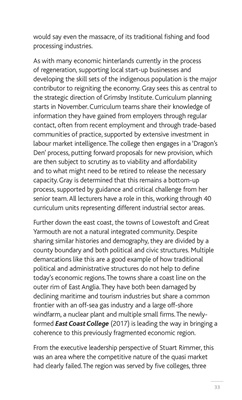
33
would say even the massacre, of its traditional fishing and food
processing industries.
As with many economic hinterlands currently in the process
of regeneration, supporting local start-up businesses and
developing the skill sets of the indigenous population is the major
contributor to reigniting the economy. Gray sees this as central to
the strategic direction of Grimsby Institute. Curriculum planning
starts in November. Curriculum teams share their knowledge of
information they have gained from employers through regular
contact, often from recent employment and through trade-based
communities of practice, supported by extensive investment in
labour market intelligence. The college then engages in a 'Dragon's
Den' process, putting forward proposals for new provision, which
are then subject to scrutiny as to viability and affordability
and to what might need to be retired to release the necessary
capacity. Gray is determined that this remains a bottom-up
process, supported by guidance and critical challenge from her
senior team. All lecturers have a role in this, working through 40
curriculum units representing different industrial sector areas.
Further down the east coast, the towns of Lowestoft and Great
Yarmouth are not a natural integrated community. Despite
sharing similar histories and demography, they are divided by a
county boundary and both political and civic structures. Multiple
demarcations like this are a good example of how traditional
political and administrative structures do not help to define
today's economic regions. The towns share a coast line on the
outer rim of East Anglia. They have both been damaged by
declining maritime and tourism industries but share a common
frontier with an off-sea gas industry and a large off-shore
windfarm, a nuclear plant and multiple small firms. The newlyformed
East Coast College (2017) is leading the way in bringing a
coherence to this previously fragmented economic region.
From the executive leadership perspective of Stuart Rimmer, this
was an area where the competitive nature of the quasi market
had clearly failed. The region was served by five colleges, three